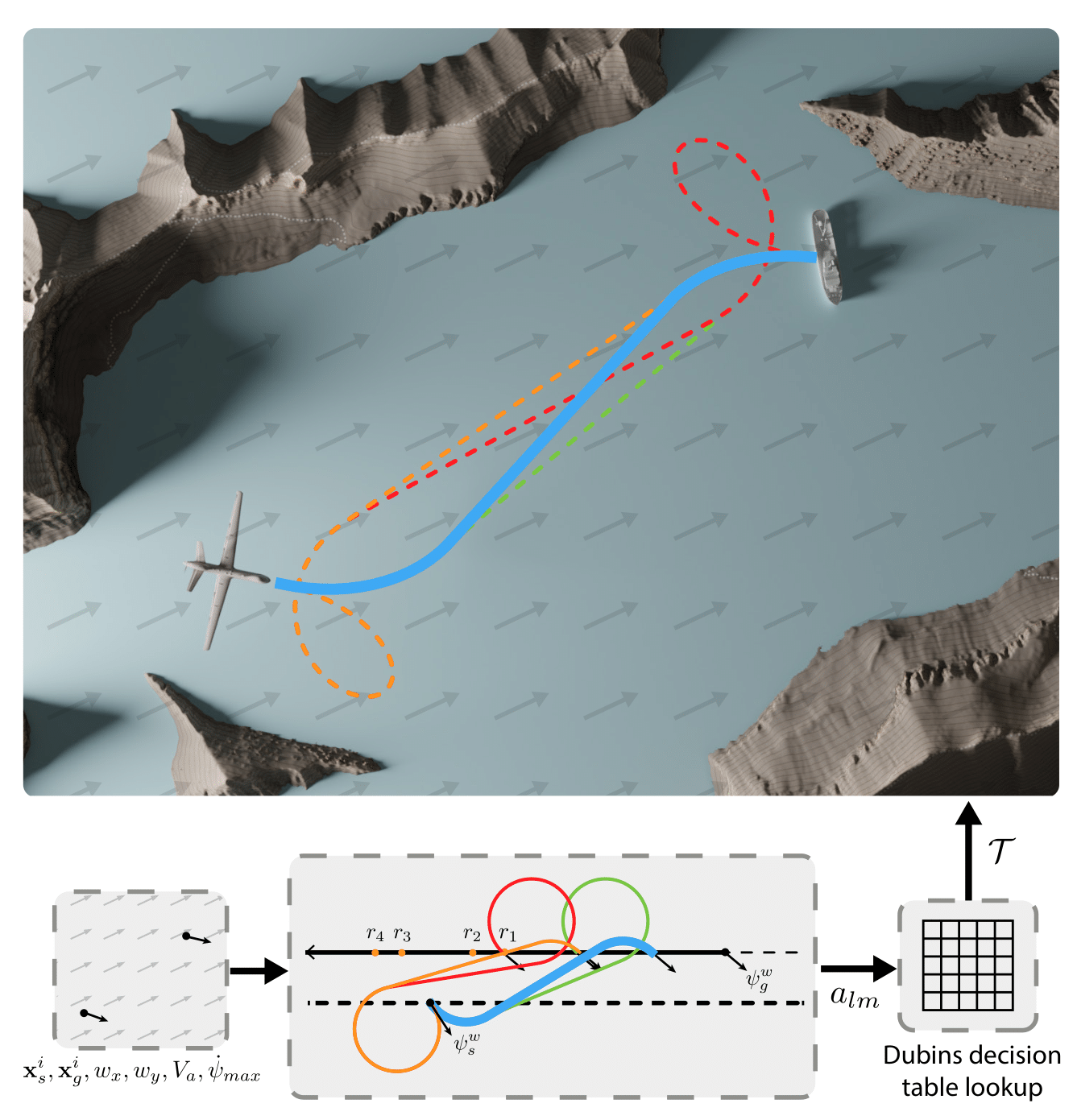Time-Optimal Path Planning in a Constant Wind for Uncrewed Aerial Vehicles using Dubins Set Classification
This repository contains code for the paper "Time-Optimal Path Planning in a Constant Wind for Uncrewed Aerial Vehicles using Dubins Set Classification" by Brady Moon*, Sagar Sachdev*, Junbin Yuan, and Sebastian Scherer (* equal contribution).
This codebase includes both a solver for trochoidal paths when there is wind as well as also solving Dubins paths when there is no wind. The Dubins path solutions use the work "Classification of the Dubins set" as well as the correction proposed in the work "Circling Back: Dubins set Classification Revisited."
Time-optimal path planning in high winds for a turning-rate constrained UAV is a challenging problem to solve and is important for deployment and field operations. Previous works have used trochoidal path segments comprising straight and maximum-rate turn segments, as optimal extremal paths in uniform wind conditions. Current methods iterate over all candidate trochoidal trajectory types and select the one that is time-optimal; however, this exhaustive search can be computationally slow. In this paper, we introduce a method to decrease the computation time. This is achieved by reducing the number of candidate trochoidal trajectory types by framing the problem in the air-relative frame and bounding the solution within a subset of candidate trajectories. Our method reduces overall computation by 37.4% compared to pre-existing methods in Bang-Straight-Bang trajectories, freeing up computation for other onboard processes and can lead to significant total computational reductions when solving many trochoidal paths. When used within the framework of a global path planner, faster state expansions help find solutions faster or compute higher-quality paths. We also release our open-source codebase as a C++ package.
- Ubuntu 18.04 or 20.04
- ROS Melodic or Noetic
- Python 3.6+ (For visualizations)
- Google Benchmark (For benchmarks)
sudo apt-get install libbenchmark-dev
Clone this repo in your catkin workspace or create a new workspace like in the following:
mkdir -p ~/trochoids_ws/src
cd ~/trochoids_ws/src
git clone git@github.com:castacks/trochoids.git
cd ../
catkin buildTo build the unit tests and run them (optional), run the following command:
catkin build --make-args testsSource the workspace.
source devel/setup.bash # devel/setup.zsh if using zshAnd then launch the unit tests with
roslaunch trochoids unit_test.launchThis will run all the unit tests contained in unit_test_trochoid.cpp and unit_test_trochoid_classification.cpp. Examples of code usage can be found in the unit tests or in the following section.
The main function for the trochoid solver is get_trochoid_path(). This function takes in the following parameters:
- Start State: [x, y, z, psi]
- Goal State: [x, y, z, psi]
- Wind: [x, y, z]
- Desired Speed (m/s)
- Max Kappa: 1/turning_radius (1/m)
- (Optional) Waypoint Distance: The distance between waypoints in the trochoid path (m)
If there is no wind, it solves for the path using a Dubins path, and if there is wind it uses a trochoidal path.
double wind[3] = {0.3, 0.5, 0};
double desired_speed = 15;
double max_kappa = .02;
double waypoint_distance = 10;
trochoids::XYZPsiState start_state = {0, 0, 110, 0};
trochoids::XYZPsiState goal_state = {500, 0, 110, 0};
std::vector<trochoids::XYZPsiState> trochoid_path;
bool valid = trochoids::get_trochoid_path(start_state, goal_state, trochoid_path, wind, desired_speed, max_kappa, waypoint_distance);If you find this work useful, please cite our paper:
@article{moon2023timeoptimal,
title={Time-Optimal Path Planning in a Constant Wind for Uncrewed Aerial Vehicles using Dubins Set Classification},
author={Brady Moon and Sagar Sachdev and Junbin Yuan and Sebastian Scherer},
year={2023},
journal = {IEEE Robotics and Automation Letters},
publisher = {IEEE},
doi = {10.1109/LRA.2023.3333167},
url = {https://arxiv.org/pdf/2306.11845.pdf},
video = {https://youtu.be/qOU5gI7JshI}
}